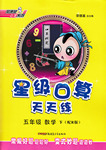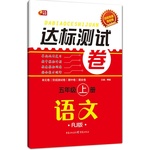题目内容
| |||||||||||||||||||||||||||||||||||||||||||||||||||||||||||||||||||||||||

 星级口算天天练系列答案
星级口算天天练系列答案 芒果教辅达标测试卷系列答案
芒果教辅达标测试卷系列答案
| |||||||||||||||||||||||||||||||||||||||||||||||||||||||||||
The Indians invented and developed the system of numbers from 1 to 9 and 0. We can use the ten numbers to make any number from the biggest to the smallest.
However, the ancient Romans invented a different system (系统) of numbers. They used symbols (符号) and replaced them. 1 is “Ⅰ” and 2 is “Ⅱ”. For larger numbers, they invented new symbols—5 is “Ⅴ”, 10 is “Ⅹ”, and so on. But they didn’t have a symbol for zero.
Here’s a table of the Roman numbers.
1 | 5 | 10 | 50 | 100 | 500 | 1,000 |
Ⅰ | Ⅴ | Ⅹ | L | C | D | M |
The Romans combined their symbols. In this way, “Ⅶ” means “5+1+1”, or 7. However, they found that “ⅡⅡ” (for 4) and “ⅤⅡⅡ” (for 9) were too confusing, so they thought out another idea.
If the “Ⅰ” comes after the “Ⅴ”, then you add it (Ⅵ is 6); if the “Ⅰ” comes before the “Ⅴ”, then you subtract (减去) it (Ⅳ is 4). The rule is that you are allowed to add up to three (e.g. Ⅷ is 8), but only subtract one (e.g. XL is 40).
How to remember the symbols?
Ⅰis like a finger. In a whole hand, the thumb (拇指) and the little finger make a V. Ten fingers are both hands, so the two Vs make an X..
Here is a way to remember the other symbols (L, C, D, M):Little Cats Drink Milk.
( ) 51. How many numbers can we make according to the Indians’ system ?
A. three: 0, 9, 1 B. ten C. eleven D. lots of
( ) 52. Which number was not in the ancient Roman’s number system?
A. 1 B. 9 C. 0 D. 5
( ) 53. What does the underlined word “combined” probably mean in the passage?
A. 合并 B. 分离 C. 增加 D. 削减
( ) 54. What does MD mean according to the Romans’ rule of calculating?
A. 500 B. 1000 C. 1500 D. 2000
( ) 55 Which sentence is NOT true according to the passage?
A. “Little Cats Drink Milk” can help us to remember some of the numbers symbols.
B. The Indians invented the system of numbers from 1 to 9 and 0.
C. You are not allowed to make a number like “XXL”
D. The ancient Romans repeated symbols to make any number.
FUN TIME
| 9 | 2 | 4 | 7 | 6 | 3 | 1 | 5 | 8 |
| 5 | 3 | 6 | 8 | 9 | 1 | 4 | 2 | 7 |
| X | 7 | 8 | 2 | 5 | 4 | 9 | 6 | 3 |
| 7 | 1 | 9 | 3 | 4 | 2 | 5 | 8 | 6 |
| 4 | 8 | 3 | 6 | 1 | 5 | 2 | 7 | 9 |
| 2 | 6 | 5 | 9 | 8 | 7 | 3 | 4 | 1 |
| 3 | 9 | 7 | 4 | 2 | Y | 6 | 1 | Z |
| 6 | 5 | 2 | 1 | 7 | 9 | 8 | 3 | 4 |
| 8 | 4 | 1 | 5 | 3 | 6 | 7 | 9 | 2 |
Are you tired of the puzzles you usually do? Sudoku is a new choice. Sudoku consists of the Japanese characters Su (meaning “number”) and Doku (meaning “single”), but it was not invented in Japan. It was created by Howard Garnes in 1979. The puzzle was first introduced into Japan by Nikoli Puzzle Company in 1984. In 1986, Kaji Maki, the president of Nikoli made the rules strict and clear. Soon in the same year Sudoku became popular in Japan. In November 2004, The Times, a British newspaper, first printed it in the newspaper. It became an international hit in 2005. Now Sudoku becomes very popular all over the world.
The rule of the puzzle is to fill in the grids (格子) so that every row, every line and every
3×3 box has the numbers 1 to 9. Here is a Sudoku. Please relax and enjoy. It’s fun!
根据以上杂志专栏内容,回答下列问题。
51. Who created Sudoku?
A. Howard Garnes. B. Sudoku. C. Kaji Maki. D. Nikoli.
52. Which is true about Kaji Maki according to the reading material?
A. He was the boss of Nissan Company.
B. He helped to make Sudoku popular in Japan.
C. He was the president of The Times.
D. He is an American.
53. Which is NOT true about Sudoku?
A. Sudoku wasn’t invented in Japan.
B. It was The Times that first printed Sudoku in the newspaper.
C. Each grid has more than one numbe![]() r.
r.
D. It became popular around the world in 2005.
54. In the puzzle above, what should “X” be?
A. 5. B. 4. C. 3. D. 1.
55. What should “Z” be in the puzzle?
A. 8. B. 5. C. 2. D. 4.